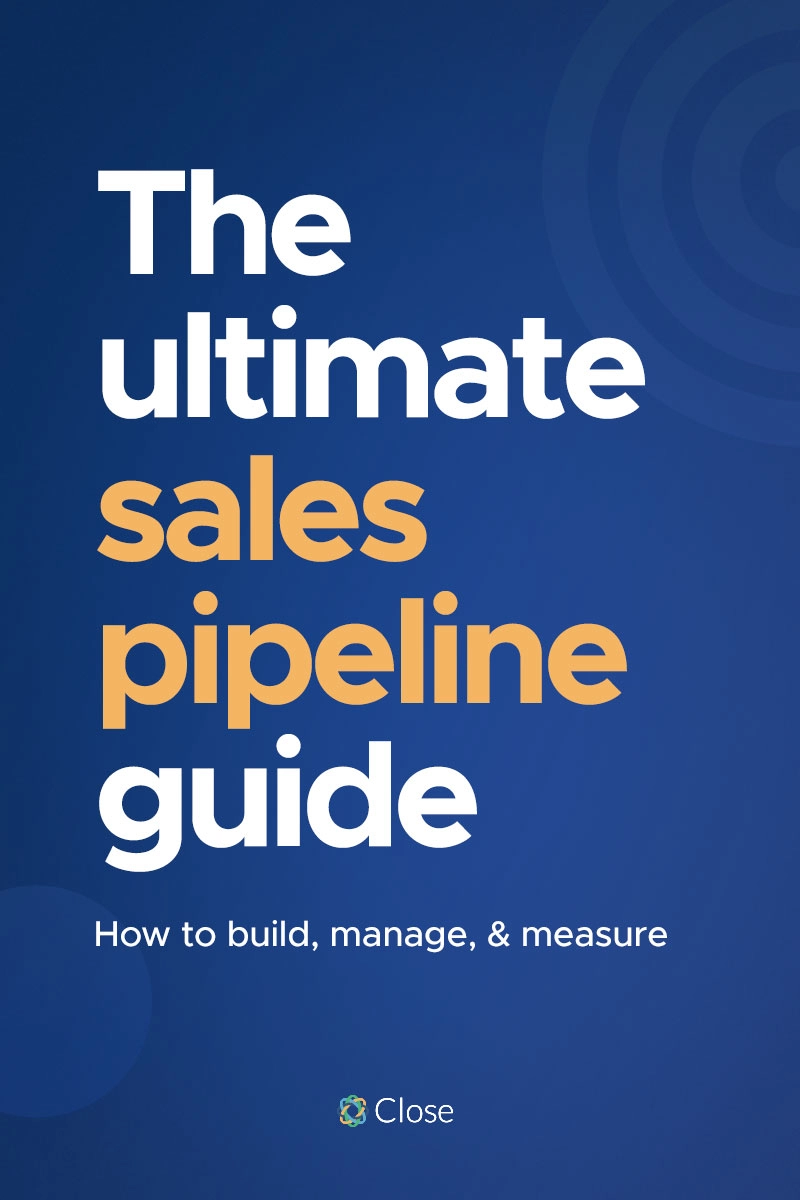In sales, it’s almost like you’re the tour guide on a fantastic journey. Every time you pick up the phone to cold call a new lead, it’s the start of a new adventure.
Your goal: Take these leads through the sales cycle and convert them into happy customers.
Like any journey, this can be both exhilarating and exhausting. It takes an insane amount of energy, knowledge of your product, and charisma.
But even the pluckiest of tour guides needs a good map to get started.
What’s the ‘map’ you use to take prospects on their journey towards a purchase?
Your sales pipeline.
Using your sales pipeline as a guide, you can smooth out the journey and make it easier for your leads to convert. This not only helps you increase customers for your product: it’ll make those customers even more valuable to your company.
If you’ve landed here, it means you want to know more about sales pipelines. Well then, you’ve come to the right place.
You’re about to learn everything you’ll ever need to know (and more) about sales pipelines.
Before we get started though, you’ll need to know the answers to these basic questions:
- What is a sales pipeline?
- What are the 6 main types of sales pipelines, and what are they used for?
- Are sales pipelines different based on your industry?
- How do sales pipelines enable sales and benefit your team?
Let’s find out...
What is a Sales Pipeline?
A sales pipeline is a visual representation of your current leads and prospects in relation to your sales process. It’s normally set up in Kanban board style, with each column representing a different sales stage.
A sales pipeline gives you a clear view of where your leads are in the sales process, how likely they are to close, and what kind of revenue you can expect when they do.

Each business has its own unique sales process. This might include different stages in the buying process or different actions you or your reps take to close a deal.
For a sales pipeline to be truly effective, you need to adapt it to your business, your customers, and your product.
In fact, many companies create multiple pipelines for different purposes, each with their own unique stages and processes.
What are some different types of sales pipelines, and which one(s) should you be using?
What are the 6 Main Types of Sales Pipelines, and What are They Used for?
Remember: the type of sales pipeline you choose will depend on how your business works and how your team sells best.
A sales pipeline is only valuable to you if it helps your team close deals faster and convert more customers.
That said, here is an overview of six popular types of sales pipelines:
1. Simple Sales Pipeline
This is your basic visual pipeline with stages such as prospecting, qualification, meeting, and close. This is best for a no-frills sales process that moves smoothly from start to finish. Leads come in, they see your product, and they purchase it.

2. Sales and Marketing Pipeline
While pipelines are mainly for sales teams, there can be quite a bit of overlap with the marketing team as well. A sales and marketing pipeline bridges the gap between these two teams, giving both access to the areas where they shine. For example, this type of pipeline might include stages at the beginning for lead generation and cater more to the inbound leads generated by marketing.

Pro Tip: A sales and marketing pipeline works best with automation, sending leads directly from your marketing tools to your pipeline. That’s why Close CRM integrates with marketing tools like MailChimp, Marketo, Hubspot, Facebook ads, Unbounce, and more!
3. Post-Sale Pipeline
Just because a deal closed, doesn’t mean your work is done. Depending on your business, you might need a post-sale pipeline that includes the work you’ll do after the contract is signed. This could include creating or designing a product, delivering or implementing it, providing a service, asking for a referral, or providing training.

4. Retargeting Pipeline
When you lose contact with a lead, put them into your retargeting pipeline. This pipeline will have specific stages to retarget lost leads down the road with relevant follow-ups.

5. Product/Service-Based Sales Pipeline
Depending on whether you’re a product-based or service-based company, your pipeline can be specifically adapted to what you sell. In fact, some companies create multiple pipelines based on the different selling processes they use for their different products.

6. Profile-Based Sales Pipeline
If you sell to very different customer profiles, a profile-based pipeline will help you sell to that specific type of customer. For example, a business that sells a product to both SMBs and enterprise companies will have a different selling process for each and could create multiple pipelines to reflect that.

These main sales pipelines guide today’s biggest businesses toward their next sales (and could be the basis for your sales pipeline).
When deciding whether or not to create multiple pipelines, remember that this only makes sense if the sales process varies greatly. Depending on your business, you may only need a simple sales pipeline that takes your customers on a clear path to the sale.
When it comes to your pipelines, the simpler the better. If you want to sell faster and shorten your sales cycle, don’t overcomplicate your sales process.
But how does your industry affect your sales pipeline?
Are Sales Pipelines Different Based on Your Industry?
Yes and no.
It’s true: a SaaS company may have a different sales process than a real estate agent or a field sales team. And a company that sells a service may have a different process than one that sells a physical product.
However, the basic sales pipeline stages still remain the same:
- Prospect to find the leads that will be interested in your product.
- Qualify those leads by researching them, their needs, their location, or other factors. Ask qualifying questions to see if they’d be a good fit for what you’re selling.
- Contact your prospect and set up a meeting, demo, phone call, or free trial. Sell them on the product.
- Present your offer with a stunning proposal.
- Negotiate and close the deal.
These basic sales pipeline stages are the foundation of your sales process and will work in pretty much any business.
Of course, different industries may have their own take on these stages. For example:
- In a SaaS sales pipeline, the ‘contact’ stage would likely include a product demo. Check out our SaaS sales guide.
- For a field sales team, the qualification stage will likely revolve around a geographic location, and contact will be done in person.
- In a B2B sales pipeline, the negotiation stage may be more complex, involving approvals from multiple stakeholders and decision-makers.
- A real estate sales pipeline will develop qualification around the type of buyer, and may be adapted based on the properties currently for sale. The negotiation stage will also involve getting a home inspection, taking an offer back to the current homeowner, returning with a counter-offer, and so on.
- For a construction sales pipeline, proposals may be in the form of blueprints, and will likely need to be adjusted and approved before the contract is signed.
That said, the basic process remains the same. What really changes are the actions that sales reps take within those different stages.
You can use the same basic process to build a sales pipeline that’s adapted to your business, customers, and product. When you do, there are some clear benefits you’re bound to see.
How Sales Pipelines Enable Sales and Benefit Your Team
With a well-developed pipeline, you’ll see at least five clear benefits:
1. Get a Clear View of all Deals Going on
A visual sales pipeline allows you to see what deals are currently in your pipeline, what stage they’re in, and how likely they are to close.
This not only helps your team set reasonable goals but also helps them achieve those goals.
Conduct regular sales pipeline review meetings to maintain a squeaky-clean pipeline that leaves you with no doubt on how to move forward and reach your goals.
2. Know Whether or Not You’re Going to Reach Your Goals
Since your pipeline shows you exactly what’s going on with your sales, you won’t sit around guessing whether you’re going to hit your quota or revenue goals: you’ll know for a fact.
For example, having a visual pipeline clearly shows you when you’re running low on leads. Instead of waiting for your pipeline to dry up, having this visual view allows you to see the drought in advance.

Then, you can implement the right methods to fix a dry sales pipeline before it even happens.
3. Shorten the Sales Cycle
A pipeline dictates an exact order for your sales process. Without that, reps are just guessing at what they should do next to push a sale forward. They might be trying to close too soon, or they might be delaying the sale for no reason.
With a sales pipeline in place, reps know exactly what they need to do, as well as the order they need to go in. Actions and next steps are outlined clearly, like a map that helps them take prospects on a smooth journey to purchase.
The rest is just common sense: the smoother your sales process, the shorter your sales cycle will be.
4. Monitor Your Team’s Progress
A good sales pipeline will also help sales managers monitor their team.
For example, managers will be able to see the stages where certain reps always get stuck, or where some reps truly excel.
This information helps sales leaders to give relevant training and encouragement, pushing all of their reps to sell better.
5. Focus on the Right Deals and Actions
With the right information in your pipeline, you’ll be able to see which deals are more valuable, which ones are losing speed, and which ones are more likely to close.
When you manage your pipeline effectively, your team will focus on the right deals. They’ll know which deals hold the most value, and which actions will lead those deals to a sale.
Ready to Blow the Doors off Your Competition?
Then let’s get into the nitty-gritty of sales pipelines.
When you build a sales pipeline that works, you’ll have a smoother process for closing big deals, and your reps will be working smarter to build your customer base.
That’s a fancy way of saying you’ll be one step closing to beating your biggest competitors.
In this guide, you’re going to learn more about what a pipeline is and what it’s not, how to build one that works for your business, what metrics you should be tracking, and how to manage your pipeline effectively.












